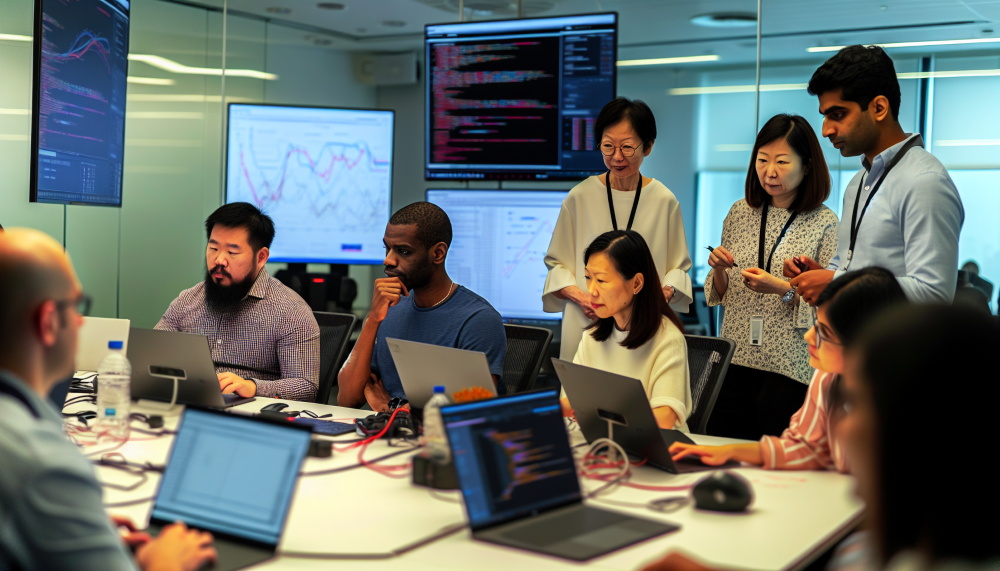Mastering Troubleshooting Category Specific Features Issues for Problem Solving: A Step-by-Step Guide
Ever hit a snag while trying to solve a problem? You’re not alone. Troubleshooting is an essential skill in our fast-paced, tech-driven world. Whether you’re dealing with a software glitch or a complex network issue, mastering troubleshooting techniques can be your secret weapon. This guide is packed with insights to help you navigate troubleshooting category-specific feature issues for problem-solving, stay ahead of evolving technologies, and become a pro at problem-solving.
Key Takeaways
Identify category-specific problems & spot patterns in errors
Consult user feedback, access knowledge bases & engage subject matter experts
Develop a systematic approach to troubleshooting, think outside the box and anticipate future outcomes
Pinpointing the Issue: Identifying Category-Specific Problems
Ever tried to solve a puzzle without looking at the picture on the box? That’s what troubleshooting feels like without proper problem identification. You’re essentially trying to solve a problem without knowing what the problem is. Don’t worry! A sound problem-solving strategy will help you pinpoint category-specific issues and devise effective solutions.
Recognizing Error Patterns
Imagine you’re a detective on the hunt for a notorious criminal. You start to notice patterns - a peculiar calling card left at each crime scene, a unique modus operandi. These patterns help you narrow down your suspect list and eventually solve the case. The basic idea is to identify and analyze these patterns to catch the criminal.
Likewise, in troubleshooting, spotting error trends aids in isolating the root cause and resolving the problem. Digital twins also come into play, offering a virtual model of a machine that can help identify and solve problems.
Consulting User Feedback
User feedback is like a goldmine of information that can help identify problems and improve system performance. It’s like having a team of amateur detectives on the case, providing crucial insights about bugs, glitches, or errors they’ve encountered.
Moreover, user feedback can help enhance user experience by identifying areas of confusion or difficulty. Attending to user feedback paves the way for system enhancement and possible solution identification.
Assessing System Logs
Imagine having a detailed diary of all the activities happening within your computer system. That’s essentially what system logs are. They capture:
error messages
warnings
transactions
other system-related data
System logs provide a historical record that is crucial for troubleshooting.
A peek into these records can help IT professionals identify problems specific to a category and make the system work better.
Gathering the Right Tools and Information
Armed with the right tools and information, a challenging troubleshooting task becomes more approachable. It’s like having a well-equipped toolbox and a detailed blueprint when you’re fixing a leaky faucet. The right tools make the job easier, and gathering information helps you understand what needs to be done.
Toolkits for Specific Categories
Just as a plumber has different tools for different tasks, different categories of problems require different toolkits. For instance, fixing IT problems might require network troubleshooting tools like Ping and Traceroute, while industrial machinery issues might require a more hands-on toolkit. The right category-specific toolkit streamlines troubleshooting, making it not just simpler but also more effective.
Accessing Knowledge Bases
Knowledge bases are like a library of problem-solving resources. They contain answers to common questions, step-by-step troubleshooting guides, and how-to instructions. Whether you’re an IT professional looking for a technical fix or a user trying to troubleshoot a minor issue, a well-organized and accurate knowledge base can be your go-to resource.
Engaging with Subject Matter Experts
Subject Matter Experts (SMEs) are like the Wise Old Elves of the troubleshooting world. Their in-depth knowledge and practical experience can provide invaluable insights, especially when dealing with complex issues.
Engaging with SMEs can open up new perspectives and help you find solutions that you might not have thought of on your own.
Developing a Systematic Approach to Troubleshooting
Formulating a systematic troubleshooting approach serves as a roadmap for problem-solving. It guides you through the process, ensuring that you don’t miss out on any crucial steps. With a systematic approach, you can effectively navigate through the maze of problems and reach the right solution using problem-solving methods.
Crafting a Troubleshooting Checklist
A troubleshooting checklist is like a treasure map. It provides a step-by-step guide to navigate through the problem-solving process, ensuring that you don’t miss out on any crucial steps.
Whether you’re dealing with a minor glitch or a major issue, a well-crafted checklist can be your guide to effective troubleshooting.
Prioritizing Potential Solutions
After potential solutions are identified, they need to be prioritized. This is like deciding which tasks to tackle first in your to-do list. Prioritizing solutions can help you manage your resources effectively, ensuring that urgent and high-impact issues are addressed first.
Documenting the Process
Documenting the troubleshooting process is like keeping a diary of your problem-solving journey. It helps you keep track of what you’ve learned, shares the knowledge with others, and creates a record for future reference.
Put simply, it’s about leveraging past experiences to enhance future outcomes.
Creative Problem-Solving Strategies for Complex Issues
Much like a well-cooked dish benefits from a pinch of creativity, complex problem-solving often necessitates out-of-the-box thinking. By engaging in the creative process, you can develop problem-solving strategies that help you look at issues from a fresh perspective, potentially leading to possible solutions, rather than relying on the obvious solution. Employing various problem-solvingmirror techniques can further enhance your ability to find innovative solutions, ultimately mastering the art of solving problems.
Thinking Outside the Box
Thinking outside the box is like exploring uncharted territories. It opens up a world of possibilities, helping you come up with innovative solutions through critical thinking.
So, next time you’re faced with a challenging problem, don’t just stick to the tried-and-tested methods, try to think differently.
Collaborative Brainstorming Sessions
Collaborative brainstorming sessions are like a jamming session in a band, where everyone contributes their unique ideas to create a beautiful melody. They can help generate a plethora of ideas and solutions, harnessing the collective intelligence of your team.
Adopting a Multi-Angled Investigation
Adopting a multi-angled investigation is like looking at a sculpture from different perspectives. Each angle provides a different view, offering unique insights into the problem. So, when you’re facing a complex issue, don’t just look at it from a single perspective.
Try to explore it from various angles.
Implementing and Testing Solutions
The implementation and testing of solutions mark the culmination of your troubleshooting journey. It’s where you put your chosen solution into action and then rigorously test it to ensure its effectiveness. But remember, the journey doesn’t end here.
Continuous improvement is key in troubleshooting.
Executing the Chosen Fix
Implementing the chosen fix equates to operationalizing your plan. It’s the moment of truth where you get to see if your solution works in practice. But remember, execution is only half the battle.
Monitoring the impact of the fix is equally important.
Verifying Solution Effectiveness
Confirming your solution’s effectiveness is akin to validating your answers in a math test. You want to ensure that your solution not only solves the problem but does so effectively. This is where conducting thorough tests and gathering feedback becomes crucial.
Iterative Testing for Reliability
Iterative testing resembles rehearsing a musical piece repeatedly until it’s perfected. It involves running multiple tests to refine your solution and ensure its reliability. Remember, the goal is not just to find a solution, but to find a solution that stands the test of time.
Ensuring Future Preparedness
Securing future readiness is akin to carrying an umbrella when rain is forecasted. It’s about being ready to tackle any future category-specific issues that might come your way.
Updating Troubleshooting Protocols
Refreshing troubleshooting protocols mirrors revising notes ahead of an exam. As technologies evolve, so should your troubleshooting protocols. Regular updates can help ensure that your protocols remain relevant and effective.
Training for Team Members
Providing training for team members equates to equipping a soldier with the right gear. Equipping your team with the necessary problem-solving skills and category-specific knowledge is crucial for effective troubleshooting. After all, a well-trained team is your best asset in the battle against tech issues.
Building a Resilient System
Establishing a resilient system resembles constructing a building on a robust foundation. It can withstand the test of time and adverse conditions. Similarly, a resilient system can handle potential vulnerabilities and ensure continuous improvement in the face of evolving technologies.
Adapting to Evolving Technologies
Adjusting to evolving technologies can be compared to acquiring surfing skills. You have to learn to ride the waves of change.
As technology continues to evolve, so should your troubleshooting approach.
Keeping Up with Tech Trends
Staying abreast of tech trends parallels keeping up with the latest fashion trends. It helps you stay relevant and ahead of the curve.
Staying informed about the latest tech trends can also help you anticipate future challenges and opportunities.
Integrating New Troubleshooting Methods
Incorporating new troubleshooting methods equates to enriching your cookbook with new recipes. It enhances your problem-solving capabilities and allows you to tackle issues in a variety of ways.
So, don’t be afraid to try new recipes in your troubleshooting kitchen!
Anticipating Future Outcomes
Projecting future outcomes is akin to possessing a crystal ball. It allows you to foresee potential challenges and opportunities in the evolving tech landscape. By considering future outcomes, you can better prepare for what lies ahead and ensure your troubleshooting skills remain relevant.
Summary
From mastering the art of pinpointing issues to keeping up with evolving tech trends, troubleshooting can be a challenging yet rewarding journey. But remember, like any other skill, effective troubleshooting requires practice, patience, and continuous learning. So, keep honing your skills, stay curious, and embrace the challenges that come your way. After all, every problem is an opportunity in disguise.
Frequently Asked Questions
What are the different categories of troubleshooting?
Troubleshooting generally consists of two categories: passive and active. Passive troubleshooting is more preventative, proactively detecting and solving potential system problems, while active troubleshooting looks for and resolves existing issues.
What are the features of troubleshooting?
Troubleshooting involves following a structured approach to identify, analyze, and resolve issues. It typically consists of seven steps such as identifying the problem, determining possible causes, testing potential solutions, and implementing a fix.
What are the five 5 techniques of troubleshooting?
The five techniques of troubleshooting include identifying the problem, establishing a theory of probable cause, testing the theory to determine the cause, developing a plan of action, and implementing the solution.
Why is it important to keep up with tech trends in troubleshooting?
Keeping up with tech trends is important for troubleshooting as it helps you anticipate challenges and opportunities, staying relevant and one step ahead.
How can I ensure the effectiveness of a solution in troubleshooting?
To ensure a solution is effective, testing should be conducted regularly and feedback should be gathered. Iterative testing can also help to ensure the reliability of the solution.






